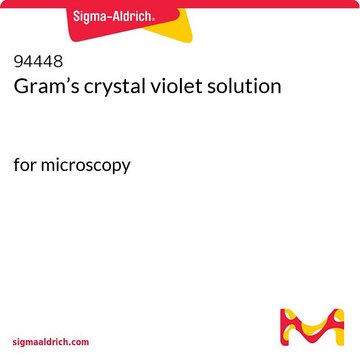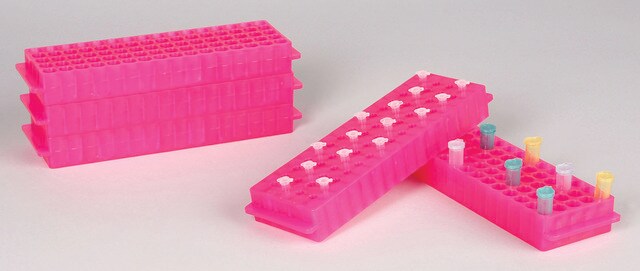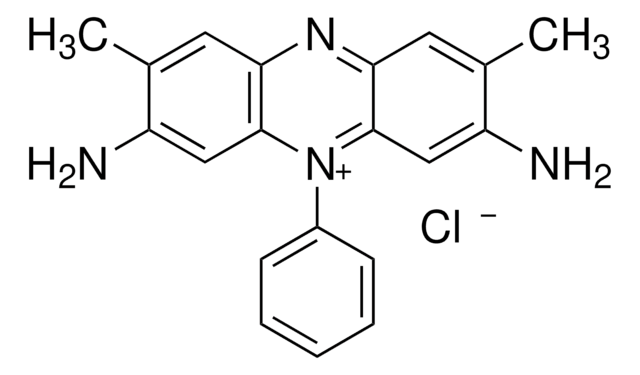V5265
Crystal Violet Solution
1%, aqueous solution
About This Item
Polecane produkty
Postać
aqueous solution
stężenie
1%
kolor
deep violet, purple
Amaks.
0.36-0.44 at 589-594 nm
Zastosowanie
diagnostic assay manufacturing
hematology
histology
temp. przechowywania
room temp
ciąg SMILES
[Cl-].CN(C)c1ccc(cc1)\C(c2ccc(cc2)N(C)C)=C3/C=C\C(C=C3)=[N+](/C)C
InChI
1S/C25H30N3.ClH/c1-26(2)22-13-7-19(8-14-22)25(20-9-15-23(16-10-20)27(3)4)21-11-17-24(18-12-21)28(5)6;/h7-18H,1-6H3;1H/q+1;/p-1
Klucz InChI
ZXJXZNDDNMQXFV-UHFFFAOYSA-M
Szukasz podobnych produktów? Odwiedź Przewodnik dotyczący porównywania produktów
Opis ogólny
It stains the fatty portions of sebaceous sweat a deep purple color. Crystal violet can also be used to enhance bloody fingerprints. This dye is harmful if inhaled, swallowed or absorbed through skin, contact may cause cancer, severe eye irritation in human beings.
Zastosowanie
- Crystal violet is commonly used in Gram staining for the classification of bacteria.
- It has also been used to detect bacterial adherence to biomedical polymers and to stain DNA in mammalian tissues in Giemsa staining.
- It has been successfully used to develop a counterion-staining method to detect DNA in agarose gel electrophoresis.
- Its antimicrobial properties have facilitated its use in the treatment of oral candidiasis, skin infections, and methicillin-resistant Staphylococcus aureus.
- It has been used as a stain in cell proliferation assays, migration assays, and Boyden chamber assay.
Działania biochem./fizjol.
Zasada
Hasło ostrzegawcze
Warning
Zwroty wskazujące rodzaj zagrożenia
Zwroty wskazujące środki ostrożności
Klasyfikacja zagrożeń
Aquatic Chronic 3 - Carc. 2 - Eye Irrit. 2
Kod klasy składowania
12 - Non Combustible Liquids
Klasa zagrożenia wodnego (WGK)
WGK 2
Temperatura zapłonu (°F)
Not applicable
Temperatura zapłonu (°C)
Not applicable
Certyfikaty analizy (CoA)
Poszukaj Certyfikaty analizy (CoA), wpisując numer partii/serii produktów. Numery serii i partii można znaleźć na etykiecie produktu po słowach „seria” lub „partia”.
Masz już ten produkt?
Dokumenty związane z niedawno zakupionymi produktami zostały zamieszczone w Bibliotece dokumentów.
Klienci oglądali również te produkty
Powiązane treści
Przegląd nauki i praktyki bakteriologii w diagnostyce klinicznej. Dowiedz się więcej o zastosowaniu standardowych i specjalnych barwników do analizy mikroskopowej.
Przegląd nauki i praktyki bakteriologii w diagnostyce klinicznej. Dowiedz się więcej o zastosowaniu standardowych i specjalnych barwników do analizy mikroskopowej.
An overview of the science and practice of bacteriology in clinical diagnostics. Learn more about the application of standard and special stains for microscopic analysis.
Nasz zespół naukowców ma doświadczenie we wszystkich obszarach badań, w tym w naukach przyrodniczych, materiałoznawstwie, syntezie chemicznej, chromatografii, analityce i wielu innych dziedzinach.
Skontaktuj się z zespołem ds. pomocy technicznej







